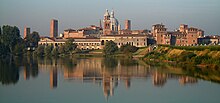Southern Lombardy is a northern region of Italy that includes the provinces of Cremona, Lodi, Mantova and Pavia. Geographically, it contains the part of the valley of the River Po, Italy's largest river, immediately north of the river, which to a large extent forms the border between Lombardy and Emilia Romagna.

Cities
edit- 1 Crema - a charming town, with one of the best medieval historic centres in the county
- 2 Cremona - on the Po river, birthplace of the Stradivarius violin
- 3 Golferenzo
- 4 Lodi
- 5 Mantua
- 6 Castel Goffredo; and 7 Castiglione delle Stiviere, the birthplace of the International Red Cross.
- 8 Pavia
- 9 Villanterio
- 10 Vigevano
- 11 Voghera
Other destinations
edit- 1 Oltrepò Pavese
- 2 Lodi Vecchio — about 7 km from Lodi, the ancient Laus Pompeia was located near today's Lodi Vecchio; the village was located on the confluence of the roads that from Placentia (Piacenza) and Acerrae (Pizzighettone) led to Mediolanum (Milan), and at the crossing point with the road that from Ticinum (Pavia) continued to Brixia (Brescia).
Understand
editThe province of Pavia consists of a flat part in the valley of the rivers Po and Ticino and a hilly part, called the Oltrepò Pavese. The latter part, although hardly known abroad, is in fact the largest wine producing region of Lombardy and has its own typical regional wines like Bonarda, Buttafuoco, Sangue di Giuda. The province offers some important sights of which the abbey of Certosa di Pavia is the most important. The city of Pavia itself is a nice, calm, relaxing historical city, with several interesting sights (tomb of Augustine, Boethius).
Get in
editGet around
editSee
editThe Abbey of Certosa di Pavia 8 km north of Pavia is one of the largest monasteries in Italy. The Certosa is renowned for the exuberance of its architecture, and for its collection of artworks.
The Piazza Ducale of Vigevano is among the most beautiful Renaissance squares in Italy.
The hills and wineries of the Oltrepò is the largest wine producing area of Lombardy, but probably also the least known one of all Italy. All wine is produced for local use, Milanese clients and for use in the spumantes of other regions (Berlucchi). The area however is worth discovering and reminds one of Tuscany: smooth hills, vineyards, magnificent views, castles, medieval cities.
The International Museum of the Red Cross in Castiglione delle Stiviere exhibits the origins and evolution of this international humanitarian organisation and documents the Risorgimento roots of modern Italy.
Do
editEat
editDrink
editStay safe
editPavia is a safe town

